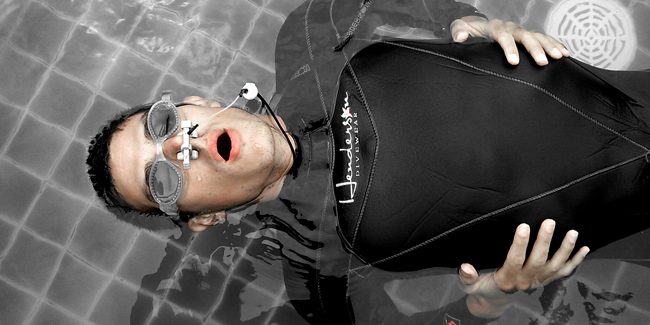One part that makes you a Freediver is the ability to hold your breath. In static apnea your breath hold skills are tested for its limits. You lay with your face down in the water and try to hold your breath for as long as possible. Your buddy is sitting next to you to make sure you won’t float away, and to assist you when needed. But besides that you are on your own.
Building up a good CO2 tolerance and thoracic cage flexibility will help you with achieving a good breath hold time. But that is only one part of the game. Doing a max performance in static apnea is mostly a mental effort. Staying calm and relaxed is the most important. But how do you do it?
Relaxation and contractions
A static breath-hold can be divided in two phases, 1) the relaxation phase followed by the 2) contraction phase. In the relaxation phase the goal is to get your heart rate as low as possible to conserve precious oxygen, but more important to produce as less CO2 as possible. It is not the lack of oxygen that triggers the urge to breathe but the accumulation of CO2 that make your lungs scream for exhalation. The contraction phase is when your diaphragm starts to contract and tries to push out the CO2.
Relaxation
During the relaxation phase you try to have happy thoughts that make you feel comfortable. Thinking about the mortgage, an upcoming exam or a deadline will stress you out and raise the heart rate. So these thoughts won’t help you with your breath hold. But you can’t force yourself to not think about it. “Don’t think of a pink elephant”, is the classic example.
Although you can’t force thoughts out of your head, you can replace them with something nice.
Mindfulness
Focusing on your body moving through the waves, or the sensation of water touching your skin. Scan through the body and examine how everything feels. While doing the body scan you try to relax every muscle fiber, from feet to jaw. Especially the jaw is often tensed up. And if you have to pee, just pee. Another sensation to focus on and distract you from holding your breath.
A story
Others make up a nice story for themselves. Imagine that you are floating in a canoe at sea and entering a mangrove that moves through the jungle where the picture gets more rich as you move up the river. Waterfalls, animals and tropical fauna coloring in the image.
The story can also be a good memory. Try to remember as much details from the experience. What did you see, how was the smell, was there music playing? Try to get as much sensations back from that memory.
Planning future events that you look forward to is also a way to get a story going in your mind. Your next holiday, a party or dinner with friends.
Contractions
OK so by now you’re laying in the water completely relaxed thinking about something nice. But then you get your first contraction. Phase two. Your body gets a little uncomfortable with the build up of CO2 and wants you to exhale. But you keep resisting. It is much harder to focus on relaxation once the contractions start. It can turn from a nice peaceful relaxation into a battle of willpower against the urge to breathe.
Some people manage to stay relaxed during the contractions. Remind yourself that at this point you still have enough oxygen in store and that it is only CO2 who tries to get your attention. But that CO2 can get really annoying and will progressively increase the contractions’ intensity to the point where you just give up.
One thing that can help is to approach the contractions as a stretching exercise. Every time you have a contraction there is a stretch of the diaphragm. As a freediver you want a flexible diaphragm and in that way you can look at contractions as something positive, just extra training.
Do what works for you
These are just a couple of strategies freedivers use to make themselves comfortable in the water. There are surely a lot of different approaches that work as well. There is never one strategy that fits all, we are all different. It a personal experiment to find out what works for you.

By Sander Verbrugge, iIntern at Blue Immersion, Koh Tao, Thailand. Sander is fascinated by what the human body is capable of, and that’s why freediving draw his attention. After he did his Level 1 at Blue Immersion; he was sold and applied for the internship. After his internship he will go back to university for his Master Human Movement Sciences.









1 Comment